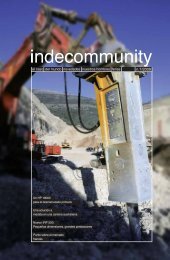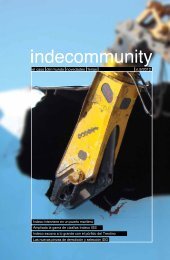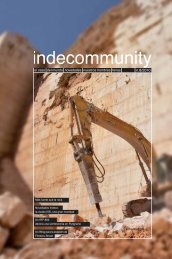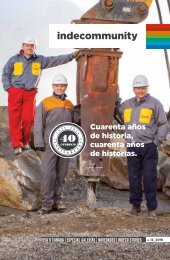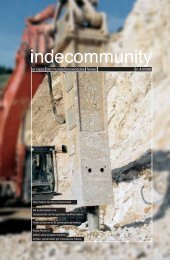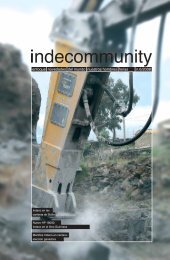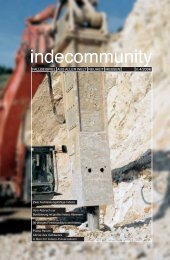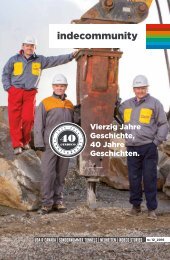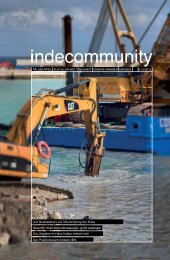Indecommunity 11/2014 (EN)
You also want an ePaper? Increase the reach of your titles
YUMPU automatically turns print PDFs into web optimized ePapers that Google loves.
il caso<br />
Geological profile<br />
Data obtained from various geognostic<br />
surveys indicated that the rock mass<br />
through which the tunnel cuts was<br />
primarily characterized by cavernous<br />
limestone with medium-poor mechanical<br />
characteristics attributable to the RMR<br />
III-IV ratings with short-term face<br />
stability but tunnel stability. However,<br />
during the stages of excavation there<br />
was determined to be a heterogeneous<br />
development of the rock from the south<br />
entrance where the tunnel face was<br />
opened. This featured limestone and<br />
compact microcrystalline dolomitic<br />
limestone, homogeneous, and resistant<br />
to being excavated. The compression<br />
strength, evaluated via sclerometer tests<br />
(Schmidt type L breaker) in that section<br />
was variable between JCS=39÷44 Mpa.<br />
Advancing with the excavation from the<br />
south entrance and working north, the<br />
rock mass immediately underwent a<br />
progressive deterioration in quality and<br />
demonstrated an ample presence of<br />
more altered portions of the formation,<br />
composed of breached limestone<br />
including dolomitic clasts with variable<br />
granulometry generally coarse-grained<br />
with calcareous cementation, from<br />
altered to very altered, slightly fractured,<br />
and relatively resistant to excavation.<br />
The compression strength of this<br />
section, evaluated via sclerometer tests<br />
(Schmidt type L breaker) was instead<br />
variable between JCS=28÷33 Mpa.<br />
The discontinuity and significant fracturing<br />
of the rock mass prompted engineers to<br />
perform short-term consolidation of the<br />
face stability using injected fibreglass<br />
tubes and sub-horizontal insertions.<br />
The consolidation of the face had an<br />
impact on project completion time, but was<br />
necessary in order to guarantee mediumterm<br />
stability, which was put at risk due to<br />
the characteristics of the rock mass. }<br />
The excavation<br />
As pointed out earlier, the tunnel<br />
measured 100 meters and according to<br />
the section, had an excavation face with<br />
a surface that varied between 136 and<br />
143 square meters (two carriageways<br />
plus emergency lane). Initially, due to the<br />
hardness and compactness of the rock<br />
characterized by limestone and compact<br />
microcrystalline dolomitic limestone,<br />
excavation output was low and chisel<br />
wear was higher-than-average. However,<br />
by using “Cobra” chisels and then, once<br />
reaching the more fractured material,<br />
output stabilized at an average excavation<br />
rate of approximately 14 cubic meters<br />
per hour corresponding to an average<br />
advance rate of two linear meters per<br />
day, considering the time required for<br />
the pre-shotcrete of the face and for the<br />
temporary lining (shotcrete, rib assembly<br />
and installation). Again using the<br />
breaker, the ribbing was created. Works<br />
commenced in early November and were<br />
completed in early March. •<br />
indecommunity pag. 4<br />
indecommunity pag. 5







